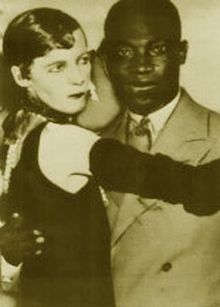


The word negrophilia[1] is derived from the French négrophilie that means "love of the Negro".[2] It was a term that avant-garde artists used among themselves to describe their fetishization of Black culture. Its origins were concurrent with art movements such as surrealism and Dadaism in the late 19th century. Sources of inspiration were inanimate African art objects (l'art nègre) such as masks and wooden carvings that found their way into Paris's flea markets and galleries alike as a result of colonial looting of Africa, and which inspired artworks such as Picasso's Les Demoiselles d'Avignon,[3] as well as live performances by Black people, many of whom were ex-soldiers remaining in European cities after World War I, who entertained as a source of low income. Equally of interest to avant-garde creators were live arts such as dance, music and theatrical performances by Black artists, as evidenced by the popularity of comic artist Chocolat and the musical review Les Heureux Nègres (1902).
- ^ Petrine., Archer-Shaw (2000). Negrophilia : avant-garde Paris and black culture in the 1920s. Thames & Hudson. ISBN 0-500-28135-1. OCLC 906987006.
- ^ According to (in French) CNRTL, the word was coined around 1803.
- ^ Gendron, Bernard (May 1990). "Fetishes and motorcars: Negrophilia in French modernism". Cultural Studies. 4 (2): 141–142. doi:10.1080/09502389000490121. ISSN 0950-2386.